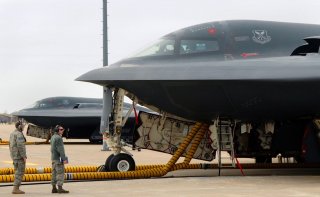America's Largest Nuke: Here's What the B83 Nuclear Bomb Can Do
One powerful weapon.
Key Point: This nuke could cause a lot of damage. And it is only a regular gravity bomb.
The B83 is one of two so-called “dumb” or unguided nuclear bombs that the United States maintains as a part of its post-Cold War Enduring Stockpile arsenal. Along with intercontinental ballistic missiles and other smaller nuclear-capable bombs, stocks of the B83 are kept in case of emergency. It replaced a number of older American free-falling weapons, and is big.
At nearly one and a half tons, the B83 is the largest nuclear bomb that the United States currently keeps. Its nuclear tiled is 1.2 megatons—significantly more powerful than either of the nuclear bombs dropped on Hiroshima and Nagasaki during World War II. It’s big, it’s powerful, and it’s had a colorful history.
Bombs Away
Though often thought of as a domain best left to Hollywood, asteroid impacts could pose a real danger to the United States. Like the blockbuster film Armageddon showed, a large enough interstellar object could end life on Earth as we known it. The threat of impact is great enough, that NASA designed a spacecraft with just one purpose—to deflect objects on a collision course with Earth.
The launch vehicles would be launched in a staggered succession, allowing NASA several “shots” at any Earth-bound projectile in case the first interceptors failed to detonate, went off course, or experienced any other operational hiccups.
The so-called nuclear interceptor would carry a total of six packages that would each carry the nuclear components from a B83. At a close enough distance, the hope was a large enough nuclear explosion would pummel the threatening interstellar body away from Earth—though this would be no guarantee of survival.
Bunker Buster
The B83 was also tentatively evaluated as a nuclear bunker-busting munition. Modifications were made to the projectile’s nose to allow it to survive impact with earth and reinforced concrete, though using nuclear weapons is fraught with political considerations. The design may have never been finalized. Either way, the Massive Ordinance Penetrator (aptly named considering its 30,000 pound, or over 13,500 kilogram weight) is the primary bunker busting bomb in the United States’ arsenal.
Postscript
In any case, the end of the line may be approaching for the B83. Its smaller and less-powerful little sibling, the B61 was recently upgraded. Though costly, the upgrades will keep the B61 in service for at least another twenty years. And the B83? It might be reserved in the future exclusively for use with the Space Force.
Caleb Larson is a defense writer for the National Interest. He holds a Master of Public Policy and covers U.S. and Russian security, European defense issues, and German politics and culture.
This first appeared in 2020 and is being reposted due to reader interest.
Image: Reuters
More From The National Interest:
Russia Has Missing Nuclear Weapons Sitting on the Ocean Floor

